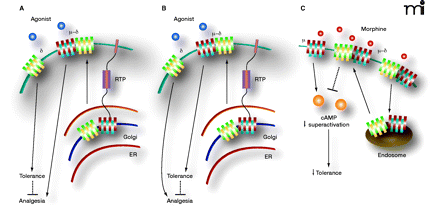
- Institution: Stanford Univ Med Ctr Lane Med Lib/Periodical Dept/Rm L109
- Sign In as Member / Individual
The Only Way Is Up: Preventing Opioid Tolerance by Promoting Cell Surface Expression of MOR-DOR Heterodimers?

Figure 2.
Schematic representation of how surface expressed MOR-DOR heterodimers could influence morphine tolerance. DORs forming heterodim-ers with MOR are chaperoned to the cell surface by interaction with RTP. It is conceivable that (A) the DOR-MOR heterodimers are anti-nociceptive and the DORs are pro-nociceptive, or (B) that DORs are anti-nociceptive and DOR-MORs are pro-nociceptive, thus contributing to tolerance. C. Heterodimers between MOR-DOR may have alternate signaling and/or trafficking properties that differ from those of MOR homomers, possibly reducing the effects of cAMP superacti-vation and, thereby, reducing tolerance.


